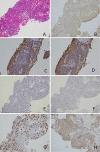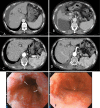Pancreatic Acinar Cell Carcinoma with Multiple Liver Metastases Effectively Treated by S-1 Chemotherapy
- PMID: 30101903
- PMCID: PMC6355402
- DOI: 10.2169/internalmedicine.0294-17
Pancreatic Acinar Cell Carcinoma with Multiple Liver Metastases Effectively Treated by S-1 Chemotherapy
Abstract
A 79-year-old woman was referred for pancreatic tail cancer with multiple liver metastases. The pancreatic tail tumor was diagnosed as acinar cell carcinoma (ACC) histologically by endoscopic ultrasound-guided fine-needle aspiration. Because of multiple liver metastases, S-1 chemotherapy was administered, resulting in a partial response to chemotherapy one year later. After approximately three years, liver atrophy and esophageal varices developed. We suspected S-1 as the cause of the liver cirrhosis. S-1 cessation minimized ascites and improved the esophageal varices. Although S-1 can potentially treat ACC, we should be watchful for liver cirrhosis caused by its long-term administration.
Keywords: acinar; chemotherapy; liver cirrhosis.
Figures






Similar articles
-
[A case of acinar cell carcinoma of pancreas with liver metastases treated effectively by S-1].Gan To Kagaku Ryoho. 2010 Jan;37(1):127-9. Gan To Kagaku Ryoho. 2010. PMID: 20087046 Japanese.
-
Long-term survival following pancreatectomy and s-1 chemotherapy for pancreatic acinar cell carcinoma with peritoneal dissemination: a case report and literature review.Medicine (Baltimore). 2015 Jan;94(1):e378. doi: 10.1097/MD.0000000000000378. Medicine (Baltimore). 2015. PMID: 25569665 Free PMC article. Review.
-
[A Difficult Diagnostic Case of Pancreatic Acinar Cell Carcinoma].Gan To Kagaku Ryoho. 2017 Nov;44(12):1235-1237. Gan To Kagaku Ryoho. 2017. PMID: 29394592 Japanese.
-
[A case of liver metastasis of pancreatic acinar cell carcinoma treated with S-1 and intra-arterial CDDP combination therapy].Gan To Kagaku Ryoho. 2010 Oct;37(10):1987-90. Gan To Kagaku Ryoho. 2010. PMID: 20948270 Japanese.
-
[A case with multiple liver metastases of gastric cancer responding completely to S-1 therapy].Gan To Kagaku Ryoho. 2010 Jul;37(7):1377-80. Gan To Kagaku Ryoho. 2010. PMID: 20647731 Review. Japanese.
Cited by
-
Acinar Cell Carcinoma with Morphological Change in One Month.Intern Med. 2021 Sep 1;60(17):2799-2806. doi: 10.2169/internalmedicine.7121-21. Epub 2021 Mar 22. Intern Med. 2021. PMID: 33746172 Free PMC article.
-
The Utility of Endoscopic-Ultrasonography-Guided Tissue Acquisition for Solid Pancreatic Lesions.Diagnostics (Basel). 2022 Mar 19;12(3):753. doi: 10.3390/diagnostics12030753. Diagnostics (Basel). 2022. PMID: 35328306 Free PMC article. Review.
-
Pathological complete response with FOLFIRINOX therapy for recurrence of pancreatic acinar cell carcinoma.Clin J Gastroenterol. 2024 Aug;17(4):776-781. doi: 10.1007/s12328-024-01983-2. Epub 2024 May 18. Clin J Gastroenterol. 2024. PMID: 38761340
References
-
- Morohoshi T, Held G, Klöppel G. Exocrine pancreatic tumours and their histological classification. A study based on 167 autopsy and 97 surgical cases. Histopathology 7: 645-661, 1983. - PubMed
-
- La Rosa S, Adsay V, Albarello L, et al. . Clinicopathologic study of 62 acinar cell carcinomas of the pancreas: insights into the morphology and immunophenotype and search for prognostic markers. Am J Surg Pathol 36: 1782-1795, 2012. - PubMed
-
- Kitagami H, Kondo S, Hirano S, Kawakami H, Egawa S, Tanaka M. Acinar cell carcinoma of the pancreas: clinical analysis of 115 patients from Pancreatic Cancer Registry of Japan Pancreas Society. Pancreas 35: 42-46, 2007. - PubMed
-
- Butturini G, Pisano M, Scarpa A, D’Onofrio M, Auriemma A, Bassi C. Aggressive approach to acinar cell carcinoma of the pancreas: a single-institution experience and a literature review. Langenbecks Arch Surg 396: 363-369, 2011. - PubMed
-
- Fitzgerald PJ, Fortner JG, Watson RC, et al. . The value of diagnostic aids in detecting pancreas cancer. Cancer 41: 868-879, 1978. - PubMed
Publication types
MeSH terms
Substances
LinkOut - more resources
Full Text Sources
Other Literature Sources
Medical

